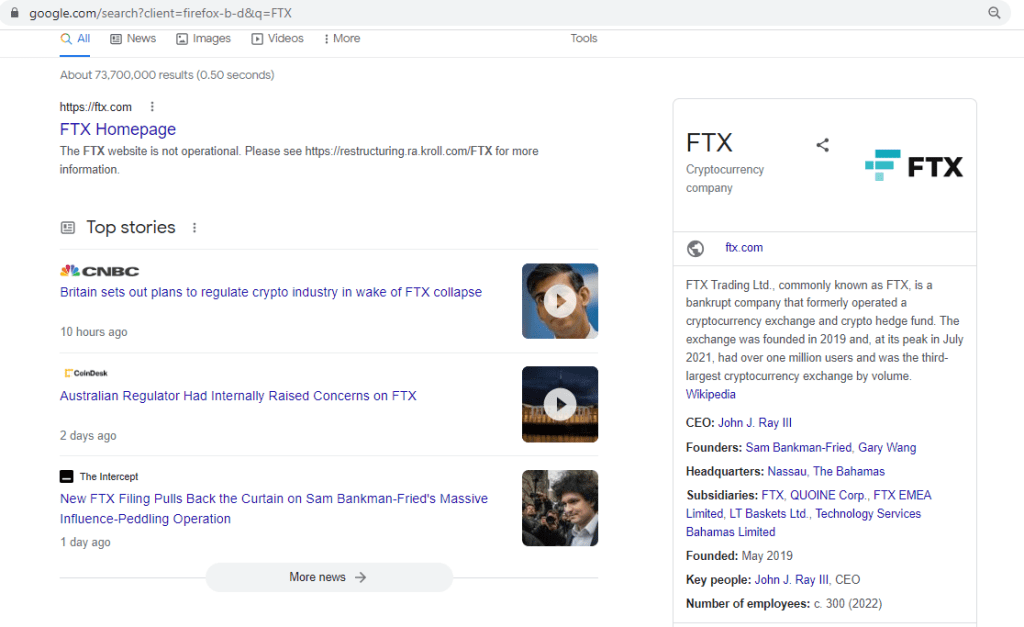What We Have Covered in This Article
Last Updated on February 10, 2023 by Editor Futurescope
FTX appeared to be a model bitcoin exchange that was operating flawlessly. However, following a precipitous decline, on November 11th, 2022, it filed for Chapter 11 bankruptcy protection. In only a few days, the company’s value plummeted from $32 billion to bankruptcy, reducing founder and CEO Sam Bankman-Fried’s net worth of $16 billion to almost nothing.
As a result of the FTX’s collapse, the already unstable cryptocurrency market lost billions of dollars, bringing it down to below $1 trillion. On November 16, 2022, a class-action complaint was submitted to a federal court in Florida, claiming that Sam Bankman-Fried had developed a fraudulent cryptocurrency scheme intended to defraud inexperienced investors from all across the nation. In the period of a single week, his kingdom collapsed.
According to a leaked balance statement from Alameda Research, Bankman- Fried’s quantitative trading business, a large amount of Alameda’s assets were denominated in tokens issued by FTX. It was previously common knowledge that FTX and Alameda were interwoven, but there was no proof to support the extent of their connection, and authorities had not taken any significant steps to probe the relationships. This article examines what went wrong with the FTX exchange.
What happened to FTX?
Bankman-Fried, then just 28, started FTX, which in three years grew to become one of the biggest cryptocurrency exchanges and was valued at $32 billion. Bankman-Fried utilized brash advertising strategies, such as a Super Bowl commercial and the acquisition of naming rights to the home of Miami Heat.
He gained notoriety for his political lobbying and fundraising, as well as his efforts to help the cryptocurrency business in general. As values plummeted at the beginning of 2022, he facilitated transactions worth almost $1 billion to save cryptocurrency enterprises suffering due to falling token prices.


In November 2022, the collapse of FTX occurred over a 10-day span. The issue was sparked by a report published by CoinDesk on November 2 detailing a $5 billion stake in FTT, FTX’s native token, owned by Alameda Research, another quant trading business controlled by Bankman-Fried.
According to the article, Alameda’s investment foundation was also invested in FTT, the token created by its sister firm, rather than a fiat currency or any cryptocurrency. That raised questions about Bankman-Fried’s enterprises unreported debt and solvency across the cryptocurrency sector.
As a replacement you can buy cryptocurrency from other reliable sources such as tabdeal.org or binance.com
Why did FTX encounter difficulties?
On November 6th, Binance, the largest cryptocurrency exchange in the world, stated it will sell its entire holding of FTT tokens, or over 23 million tokens with a market value of nearly $529 million. As a result, FTT’s price dropped and traders hurried to withdraw from FTX, fearing that it would become yet another defunct cryptocurrency firm.
Over three days, FTX hurried to handle withdrawal requests totaling an estimated $6 billion. It seemed to be experiencing a liquidity crisis, in which it lacked the funds necessary to meet customer demands. Binance said on November 8 that it has signed a nonbinding agreement to acquire FTX’s non-U.S. company for an unknown amount, thereby rescuing its closest competitor.


Mr. Bankman-Fried said in a contemporaneous release that the transaction would safeguard clients and enable FTX to complete processing their withdrawals. He said, “We are in the best of hands,” to counter claims that FTX and Binance conflicted with one another.
A day after making the rescue promise, Binance withdrew from the agreement. The exchange said on November 9 that it will terminate the FTX deal after corporate due diligence revealed, among other problems, mismanagement of client cash.
Bankman-Fried acknowledged on Twitter that FTX’s non-U.S. exchange lacked the necessary money to satisfy client requests on November 10, the same day he issued an apology for the liquidity situation. The California Department of Financial Protection and Innovation stated on the same day that it had launched an inquiry into FTX.
On November 11th, Bankman-Fried resigned as CEO of FTX and was replaced by John J. Ray III, who had previously led energy trading major Enron through bankruptcy procedures. On the same day that FTX filed for Chapter 11 bankruptcy protection, it disclosed that around 130 linked entities were also involved in the proceedings. According to the bankruptcy documents, FTX has assets between $10 billion and $50 billion and liabilities between $10 billion and $50 billion.
A few hours after declaring bankruptcy, FTX claimed it had been the target of “unauthorized transactions” and said it would place its digital assets in cold storage to protect them. Bitcoin and other cryptocurrencies belonging to the defunct FTX exchange were seized by the Securities Commission of the Bahamas (SCB) on November 18.
How does this impact the cryptocurrency sector?
Since its inception, the cryptocurrency business has battled to gain the confidence of authorities, investors, and average consumers. It will take time for the larger effects of the FTX debacle on the cryptocurrency sector to become clear.
As the greatest decline in the brief history of cryptocurrencies, FTX may discourage investors who are already wary due to worries about stability and security. If FTX users can’t get their money back, they could have to take legal action.
The failure of FTX may prompt the U.S. Securities and Exchange Commission (SEC) and other authorities to increase their scrutiny of cryptocurrencies, and Congress may be more willing to pass new rules regulating digital tokens and exchanges. The collapse of the third-largest cryptocurrency exchange by trading volume will send shock waves across the crypto community for some time.
Conclusion
FTX, a cryptocurrency exchange, failed during a 10-day period in November 2022. After a study raised questions about the exchange’s leverage and stability, the market experienced a liquidity crisis, and negotiations to get a rescue by competitor Binance swiftly broke down. In the span of a few days, FTX had its assets blocked, its CEO quit, and it filed for bankruptcy. It is impossible to make an accurate prediction about the continued ramifications that this has for the future of FTX and the cryptocurrency sector as a whole.









